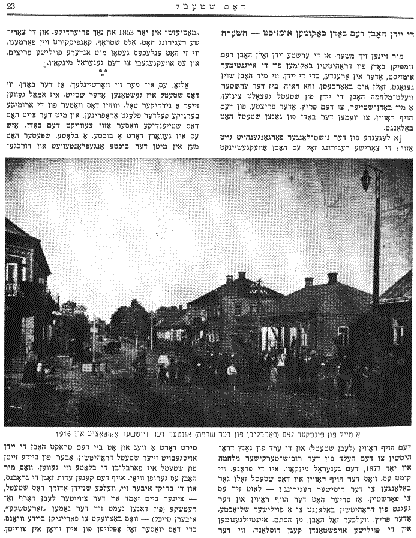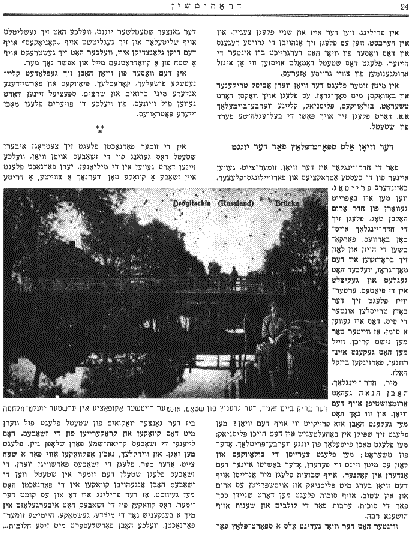 [
Page 23
]
[
Page 23
]
 [
Page 24
]
[
Page 24
]
In the springtime, when the ice and snow would melt, and in autumn when the
great rains would begin and the water of the Vion reached the houses, the
shtetl would look like an island embraced by two great lakes.
In the middle of the summer the Vion would dry out a bit, and
tcherot,
moss, reeds, small weeping willows, etc. would grow there. Wagon-drivers'
horses from town would also graze there.
The Vion as a place for youth and sports
The Vion in the summer time was one of the greatest attractions and amusement
spots for the school children, especially on Fridays, when the children got out
of
cheder
around noon. The
cheder
boys would go around barefoot, roll up their pants, and run around in the moss
that brushed and tickled the soles of the feet. In certain spots the ground
would shake under your feet. This was a sign not to go any further, since if
you did, you could sink up to your neck.
We schoolboys took pleasure in goofing off at the Vion. Where else were we as
free as at the Vion? We played hide-and-seek in the high moss; we made whistles
from young willows or
tcherot;
we would tear the reeds and toss them to the wind like feathers or stick them
on each other's collar. We would go out onto the Vion mountains on the festival
of Shavuot and gather moss and spread it around and at home. On the festival of
Sukkot, we would cut down branches to cover the tops of sukkahs, willow
branches to be joined with the palm branches, and additional willows for the
last day of Sukkot,
Hoshana Raba
.
In the winter the Vion served as a place to play sports for all the youth of
the shtetl. The youth would go sleigh riding with horses on the thick gleaming
ice that extended for a square mile, and perhaps even more.
Small fish, porgies, leeches and various other species of creatures creeping
animals multiplied. The area was also full of loaches, which the peasants used
for their special dishes.
[Photo:] The bridge next to the sand at the edge of town, under German
occupation during World War I.
JewishGen, Inc. makes no representations regarding the accuracy of
the translation. The reader may wish to refer to the original material
for verification.
JewishGen is not responsible for inaccuracies or omissions in the original work and cannot rewrite or edit the text to correct inaccuracies and/or omissions.
Our mission is to produce a translation of the original work and we cannot verify the accuracy of statements or alter facts cited.
 Drogichin, Belarus
Drogichin, Belarus
 Yizkor Book Project
Yizkor Book Project
 JewishGen Home Page
JewishGen Home Page
Copyright © 1999-2025 by JewishGen, Inc.
Updated 3 Dec 2001 by LA